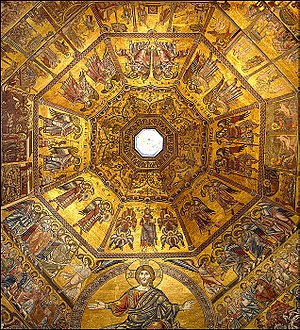

The octagonal dome of the Florentine Baptistery contains one of the most impressive mosaic programs from the Medieval era. The arrangement of the
To design the complicated, exceptional program of mosaics, the Opera del Duomo and Arte di Calimala hired Venetian mosaicists. Venetian artists were experts in the Byzantine style that dominated mosaic art in the eleventh and twelfth centuries. But while the guilds hired outside the city for the execution of the mosaics, they turned to native talent for the actual design. Attributed to Florentine painter Coppo di Marcovaldo, the
The central image consists of a full-length Christ Enthroned, framed on either side by a depiction of the Last Judgement.
Though a systematized division of Hell does not appear in the same way as in Giotto’s fresco at the Scrovegni Chapel in Padua, the sensational nature of the mosaics in the Baptistery would have provided a strong visual basis for Dante Alighieri’s equally vivid literary description.
The uppermost cycle contains the choirs of angels, helpfully labeled according to their rank. Like many Medieval artistic programs, these mosaics present the angels according to the early Medieval work On the Celestial Hierarchy, written by Pseudo-Dionysius the Areopagite, an enigmatic monk from Syria. His understanding of the angelic hierarchy placed it in parallel with the earthly hierarchy of the Church; until the Second Vatican Council in the 1960s, the religious orders contained more divisions than just the priest and bishop.
The lowest ring depicts scenes from the life of St. John the Baptist, the patron saint of the city who lends his name to the Baptistery itself. Considered the last of the Old Testament prophets and the first of the New Testament saints, John the Baptist figured prominently in both Eastern and Western churches. The city celebrated the saint’s feast day
Bibliography
Aidan Valente